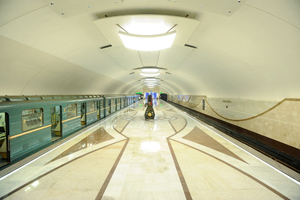Home page
» TRANSPORT
» Metro
Metro In the early 30s of the XX century Baku became one of the most populated industrial, cultural and scientific centers of not only the Caucasus, but of the former USSR as well. Therefore, after the subway construction in Moscow and Leningrad, the initial versions of the General Plan over the development of Baku city held to construct metro in 1932. However, after a while the 1941-1945 war burst out and hindered the realization of these plans. Only in 1947, two years after the destructive war the Government decided to begin project-research works. In 1949, the construction base of the metro was formed, in 1954 the technical project of the first line was approved and construction of the 12.1 kilometer line was launched. Lines of the main road were parallel to the bay and 500-700 meters apart from the seaside. In 1966, Baku Metro Office was established with 6 services including movement, motion trains, road and tunnel facilities, sanitary equipment and electromechanics, signing and communication, material-construction provision service. On November 6, 1967, five stations- Baku Soviet, 26 Baku Commissars, 28 April, Ganjlik and Nariman Narimanov stations and I shift of 9.2 kilometers underground railways were put into operation. Four stations were in great depth, one of them was “Khatai” station in a place called Black city. Beginning from November 25, 1967, the subway was continuously used and regular movement of the trains began. The second shift of 9.1 kilometers passed from the north-west parts of Baku highlands and this area was completed with the construction 5 metro stations in 1985, two of which are in great depth. Cafar Cabbarli station was put into operation in 1993. It was constructed as the passage to the 28 May station. European Union allocated 4.1 million euros to complete Hazi Aslanov station, which was put into operation in 2002. Nasimi station was put into operation on October 9, 2008. Azadlig Avenue (Liberty Avenue) station was put into operation on December 30, 2009. Dernegul station was put into operation on June 29, 2011. Currently, the Baku metro consists of 2 lines with the total length of 34.6 kilometers and 23 operating stations and 2 stations that are under construction. These stations have 23 vestibules. 7 stations have great depth. In the metro, there are 39 escalators of 5 types and the total length of the stairs zone is more than 4 000 meters. Total length of tunnels is more than 17.1 kilometers. The uncommon feature of Baku metro is that its lines have been constructed over the intersecting relief of the city located in the hilly area and there are many slopes of 60% and 40% and crooks of small radius. 
Lines and stations 18.36 km Icheri sheher –Hazi Aslanov 6.5 km 1967 Icheri sheher- N.Narimanov 7.4 km 1972 N.Narimanov- Neftchiler 3.0 km 1989 Neftchiler- Ehmedli 1.46 km 2002 Ehmedli- Hazi Aslanov 14.8 km Dernegul- Guneshli 2.3 km 1968 28 May- Khatai 6.7 km 1976 28 May- Nizami 6.7 km 1985 Nizami- Memar Acami 2.1 km 2008 Memar Acami- Nasimi 1.3 km 2009 Nasimi- Azadliq avenue 1.5 km 2011 Azadliq avenue- Darnagul Baku metro in the Guinness book of records Because of the fire that broke in the train in the tunnel between “Ulduz” and “Narimanov” stations 300 were dead, 400 were injured on October 28, 1995. This accident was included into the Guinness book of records as the most terrific metro accident. So Baku metro, which had been added to the Guinness book of records as the first metro in the East, was mentioned in history this time for the magnitude of the tragedy. The first indicator is included to the permanent records list. The third record coincides with the independence period. Baku metro has been the cheapest railway transport network in the world and has hold that world record nearly for 15 years.
|
